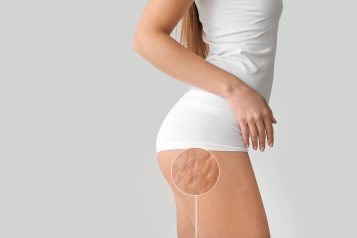Historically, there has been a lot of emphasis on skincare making you look good rather than feel good and stay healthy. It can also be seen as vain or frivolous to devote time to a ‘beauty regimen.’ But the skin is the body’s largest organ. It’s waterproof, dynamic, self-healing, and the first line of defense between us and the outside world. That’s why skincare is for everyone, and caring for your skin should be no more gendered than caring for your heart, lungs, or teeth. Despite this, cultural stereotypes and other barriers mean men are less likely than women to seek dermatological care, only visiting dermatologists with specific problems after enduring pain, discomfort, and declining self-esteem. We need to change that! Everyone has skin, and everybody’s skin deserves care.
 Photo Credit: Courtesy of Shutterstock
Photo Credit: Courtesy of Shutterstock
Not Just Teenage Troubles: Acne in Adult Men
Acne is often seen as a teenage problem, marked by whiteheads, blackheads, greasy foreheads, and angry red bumps under the skin. However, it affects people of all ages and can persist well into adulthood.
It arises from the accumulation of dead skin cells and sebum in hair follicles, clogging pores. In young men and boys, a sudden increase in testosterone and androgens increases the production of natural oils and accelerates cell turnover, leading to pores that get more congested more often. As male hormone levels peak in the late teens to early twenties, inflammatory acne can persist until testosterone levels slowly decline at a rate of about 1% per year in men’s 30s and 40s. Dermatologists can recommend tailored treatments for this stubborn acne, such as topical and oral medications, chemical peels, or laser therapy.
Understanding Rosacea: Triggers and Treatments
While women are three times more likely than men to develop rosacea, men are more likely to experience severe cases, particularly rhinophyma rosacea (thickening of the skin on the nose) and papulopustular rosacea (acne-like breakouts).
The exact causes of this chronic skin condition are not fully understood, but genetic and environmental factors like sun exposure, stress, and certain foods that cause flare-ups are known to play a role. Dermatologists can help patients identify triggers and recommend lifestyle modifications to alleviate symptoms. Treatments may also include topical or oral medications and tips on adapting shaving techniques and products to help manage flare-ups and relieve discomfort.
 Photo Credit: Courtesy of Shutterstock
Photo Credit: Courtesy of Shutterstock
Skin Relief: Tackling Eczema and Psoriasis
Psoriasis and eczema are both autoimmune conditions. Psoriasis is an autoimmune condition in which the body’s immune system mistakenly attacks its own healthy skin cells. This causes a rapid turnover of cells, leading to thick, scaly patches on the skin for patients with psoriasis. Those with eczema will experience inflammation, leading to dry, itchy, red skin due to an overactive immune response triggered by everyday elements.
Both chronic inflammatory skin conditions are heavily influenced by immune and hormonal factors like testosterone. Testosterone modulates the immune system by suppressing some immune responses; as testosterone gradually declines with age, the severity and frequency of flare-ups can increase due to less suppression of that immune response.
Effective management of eczema and psoriasis involves understanding your body’s unique triggers, such as stress, skin injuries, weather changes, underlying health conditions, and hormones. Dermatologists can prescribe topical corticosteroids, immunomodulators, or systemic medications to manage symptoms and prevent flare-ups.
 Photo Credit: Courtesy of Shutterstock
Photo Credit: Courtesy of Shutterstock
Facing Male Pattern Baldness Head-On
Male pattern baldness, or androgenetic alopecia, is a common concern among men, causing thinning hair or bald patches. It’s primarily driven by genetics and the hormone dihydrotestosterone (DHT), which causes hair follicles to shrink and hair to thin over time. This condition can begin in the late teens to early twenties and progress throughout life. Early signs include a receding hairline and thinning on the crown. This thinning and loss are mostly hereditary, though hormonal factors, stress, poor diet, and trauma to the hair follicles (from wearing baseball caps too tightly, for example) can accelerate or exacerbate hair loss. Dermatologists can assess the underlying causes and recommend tailored treatments such as minoxidil, finasteride, or hair transplant surgery to promote hair growth and restore confidence.
 Photo Credit: Courtesy of Shutterstock
Photo Credit: Courtesy of Shutterstock
Outdoorsmen: Guarding Against Skin Cancer
Studies show that men tend to be less vigilant about sun protection than women, so occupational exposure from outdoor jobs and hobbies like fishing results in higher cumulative UV exposure. The face, ears, neck, and back are often vulnerable—the scalp is also an issue for anyone with very fine or thin hair or an exposed scalp. Like the ears and back, this area is hard to see on your own, so it can be difficult to spot changes that would signal a visit to the doctor is in order. An annual “skin physical” is the best opportunity to check the body for signs of skin cancer, monitor moles, and address other concerns. In the meantime, everyone should wear sunscreen with broad-spectrum UVA/UVB protection. Experiment with chemical and mineral-based options until you find one that suits your skin and lifestyle.
Father Time and Aging Well
Men typically have thicker dermal and epidermal layers due to higher collagen density, thanks to testosterone, which stimulates the production of structural proteins such as collagen, increasing firmness and elasticity. This difference between the sexes begins at puberty and is maintained throughout life, as men lose testosterone slower than women lose estrogen.
Regardless, men are increasingly seeking anti-aging treatments to combat signs of aging, such as wrinkles, fine lines, and sagging skin, as they notice changes in their skin’s tone and texture in their late 30s and early 40s. Key aging concerns for men include deeper facial wrinkles and loss of skin elasticity, often exacerbated by lifestyle choices like smoking and sun exposure, as well as increased dryness from slowed sebum production.
Frequent shaving can also exacerbate dryness and irritation, leading to more frequent razor burns or abrasions. It is important to choose skincare products that provide extra hydration and moisture for comfortable shaving. Otherwise, chronic irritation can lead to damage that accelerates signs of aging.
Your dermatologist may recommend procedures like Botox injections, dermal fillers, or laser resurfacing to rejuvenate the skin and restore a youthful appearance.
 Photo Credit: Courtesy of Shutterstock
Photo Credit: Courtesy of Shutterstock
So, what’s keeping men from embracing self-care routines for their skin?
Introducing men to skincare through gifts can be a subtle way to encourage them to start their routine. Start simple, both in variety and ingredients. You can skip over actives like retinol or acids and focus on fragrance-free options suitable for various skin types. Start with basic steps that are easy to follow: a good basic routine can include just two products—a cleanser and a moisturizer with broad-spectrum UVA/UVB protection.
For more information, visit Dr. Brian A. Levine's social media:

























